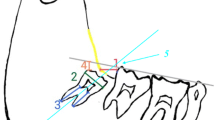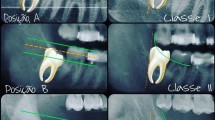Abstract
Objective
The aim of this study was to examine the relationship between ramus height, gonial angle and impaction classifications of mandibular third molars.
Methods
A total of 829 mandibular third molars in 601 patient’s orthopantomography (OPG) and cephalometric radiography records were evaluated. Gonial angle was measured on cephaloametric radiography and ramus height was measured on OPG. Impacted third molars were classified according to Pell & Gregory Vertical/Winter classification on OPG. The relationship between the impaction classifications and ramus height/gonial angle was evaluated.
Results
Statistically significant difference was found in Pell & Gregory Classification types in terms of ramus height/gonial angle (p < 0.001). Significant difference was found in terms of Gonial angle in Winter Classifications (p < 0.001). Ramus height was found to be lower than 3.8 cm in patients with an angle less than 123.8° (sensitivity 78%, specificity 84%).
Conclusions
Correlation between ramus height/gonial angle and impaction classification types of mandibular third-molar teeth was detected.




Similar content being viewed by others
References
Vranckx M, Ockerman A, Coucke W, Claerhout E, Grommen B, Miclotte A, et al. Radiographic prediction of mandibular third molar eruption and mandibular canal involvement based on angulation. Orthod Craniofac Res. 2019;22:118–23.
Mercier P, Precious D. Risks and benefits of removal of impacted third molars. A critical review of the literature. Int J Oral Maxillofac Surg. 1992;21:17–27.
van der Linden W, Cleaton-Jones P, Lownie M. Diseases and lesions associated with third molars. Review of 1001 cases. Oral Surg Oral Med Oral Pathol Oral Radiol Oral Endod. 1995;79:142–5.
Bataineh AB, Albashaireh ZS, Hazza'a AM. The surgical removal of mandibular third molars: a study in decision making. Quintessence Int. 2002;33:613–7.
Garcia AG, Sampedro FG, Rey JG, Vila PG, Martin MS. Pell–Gregory classification is unreliable as a predictor of difficulty in extracting impacted lower third molars. Br J Oral Maxillofac Surg. 2000;38:585–7.
Lysell L, Rohlin M. A study of indications used for removal of the mandibular third molar. Int J Oral Maxillofac Surg. 1988;17:161–4.
Marciani RD. Complications of third molar surgery and their management. Atlas Oral Maxillofac Surg Clin North Am. 2012;20:233–51.
Pell GJGB. Impacted mandibular third molars: classification and modified technique for removal. Dent Dig. 1933;39:330–8.
Juodzbalys G, Daugela P. Mandibular third molar impaction: review of literature and a proposal of a classification. J Oral Maxillofac Res. 2013;4:e1.
Ramiro-Verdugo J, De Vicente-Corominas E, Montiel-Company JM, Gandia-Franco JL, Bellot-Arcis C. Association between third molar agenesis and craniofacial structure development. Am J Orthod Dentofac Orthop. 2015;148:799–804.
Sanchez MJ, Vicente A, Bravo LA. Third molar agenesis and craniofacial morphology. Angle Orthod. 2009;79:473–8.
Abu Alhaija ES, AlBhairan HM, AlKhateeb SN. Mandibular third molar space in different antero-posterior skeletal patterns. Eur J Orthod. 2011;33:570–6.
Hassan AH. Mandibular cephalometric characteristics of a Saudi sample of patients having impacted third molars. Saudi Dent J. 2011;23:73–80.
Ahila SC, Sasikala C, Kumar BM, Tah R, Abinaya K. Evaluation of the correlation of ramus height, gonial angle, and dental height with different facial forms in individuals with deep bite disorders. Ann Med Health Sci Res. 2016;6:232–8.
Habets LL, Bezuur JN, Naeiji M, Hansson TL. The orthopantomogram, an aid in diagnosis of temporomandibular joint problems II The vertical symmetry. J Oral Rehabil. 1988;15:465–71.
White S, Pharoah M. Oral radiology principles and interpretation. USA: Mosby Elsevier; 2009.
Winter G. Impacted mandibular third molars. St Louis: American Medical Book Co.; 1926.
Peterson LJ. Principles of management of impacted teeth. Louis: Mosby; 1998.
Richardson ME. The etiology and prediction of mandibular third molar impaction. Angle Orthod. 1977;47:165–72.
Behbehani F, Artun J, Thalib L. Prediction of mandibular third-molar impaction in adolescent orthodontic patients. Am J Orthod Dentofac Orthop. 2006;130:47–55.
Bjork A. Variations in the growth pattern of the human mandible: longitudinal radiographic study by the implant method. J Dent Res. 1963;42(1):400–11.
Gaddipati R, Ramisetty S, Vura N, Kanduri RR, Gunda VK. Impacted mandibular third molars and their influence on mandibular angle and condyle fractures—a retrospective study. J Craniomaxillofac Surg. 2014;42:1102–5.
Mehra A, Anehosur V, Kumar N. Impacted mandibular third molars and their influence on mandibular angle and condyle fractures. Craniomaxillofac Trauma Reconst. 2019;12:291–300.
Naghipur S, Shah A, Elgazzar RF. Does the presence or position of lower third molars alter the risk of mandibular angle or condylar fractures? J Oral Maxillofac Surg. 2014;72:1766–72.
Sugiki Y, Kobayashi Y, Uozu M, Endo T. Association between skeletal morphology and agenesis of all four third molars in Japanese orthodontic patients. Odontology. 2018;106:282–8.
Altan ABSE, Ucdemir E, Sandalci S, Karaman AI. Dentofacial Morphology in third molar agenesis. Turkish J Orthod. 2015;28:7–12.
Endo T, Yoshino S, Ozoe R, Kojima K, Shimooka S. Association of advanced hypodontia and craniofacial morphology in Japanese orthodontic patients. Odontology. 2004;92:48–53.
Björk AJE, Palling M. Mandibular growth and third molar impaction. Acta Odont Scand. 1956;14:231–71.
Author information
Authors and Affiliations
Corresponding author
Ethics declarations
Conflict of interest
Author Zeynep Gümrükçü, Emre Balaban and Mert Karabağ declares that they have no conflict of interest.
Ethical approval
All procedures followed were in accordance with the ethical standards of the responsible committee on human experimentation (The Non-Interventional Clinical Research Ethics Committee of Recep Tayyip Erdoğan University, Medicine Faculty approved this study with decision no: 2019/25, dated: 20.02.2019) and with the Helsinki Declaration of 1975, as revised in 2008.
Additional information
Publisher's Note
Springer Nature remains neutral with regard to jurisdictional claims in published maps and institutional affiliations.
Rights and permissions
About this article
Cite this article
Gümrükçü, Z., Balaban, E. & Karabağ, M. Is there a relationship between third-molar impaction types and the dimensional/angular measurement values of posterior mandible according to Pell & Gregory/Winter Classification?. Oral Radiol 37, 29–35 (2021). https://doi.org/10.1007/s11282-019-00420-2
Received:
Accepted:
Published:
Issue Date:
DOI: https://doi.org/10.1007/s11282-019-00420-2




